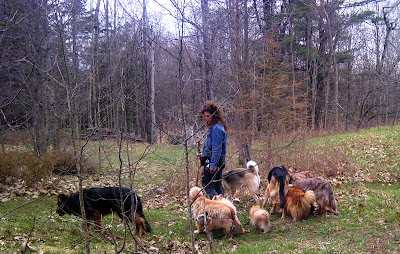YOUR DOG OWNS YOUR DOOR AND JUMPS ON GUESTS
Well guys, were to start? Training you say…yeap…but not your dog…we start with training you! And you will coach your dog from the position of Pack Leader.
So let’s get started.
The first thing you need to know is that if you ask your dog the right way your dog will stop jumping on guests. We don’t have to train him for this we just have to communicate with him properly.
To start - you need to realize that nothing you say will have any affect if you do not first train yourself to be aware of your own state of being. I would make a guess that at this moment, every time you have guests ring that door bell, you anticipate that your dog will jump all over your guests. Just anticipating this makes you tense, upset, frustrated. But you know what…you are adding and abetting the situation! You are being reactive - that is not coaching and mentoring your dog, but it is matching your dog's excited state - you see where the problem is? Dogs dislike hypocrisy even more that humans do! Your emotional state feeds your dog's state.
Please read this to get a head start on understanding the psychology of your relationship with your dog...
How Dogs Assign Respect
and
Sensitvity of Dogs
Once you have had a chance to read these articles (to do so will only take you a matter of minutes) you can better understand what follows…
I teach my client's how to own the door & establish a boundary around it, I show the dog its boundary. While doing this I teach the people how their screaming, yelling & various other 'methods' of 'instructing' their dog to stop barking is hypocritical - as they (the people) are also excited & barking! I show them how to do all this without speaking, I show them how their excited state fuels their dogs excited state & within a matter of minutes - viola! Everyone understands, sanity & balance is restored & everyone is happy! This actually gets its first go, when I walk through the door - as soon as I enter the house (barking, excited dog owning door greetings are typical) - I do not talk, I walk in calm, confident with the expectation that my person, my space will be respected. I communicate to the dog (without talking) where there place to sit or stand is, peoples jaws drop & they ask 'how did you do that', 'what did you do?' and 'my dog has never behaved so polity before or calmed down so fast?'
Setting your expectations, possessing calm confidence, patience, will and persistence is everything! Tugging, pushing, dragging your dog is engaging in an argument with your dog - this is not providing direction...and again you are engaging, reinforcing and matching your dog’s state.
To stop unwanted behaviour, you have to completely disengage your emotions and instead engage yourself as you would in your job - to work to a goal in a logical calm and deliberate manner.
You need to coach and mentor your dog, not argue with it.
Think for a moment about the tools and strategy that your dog uses to take over your space and your guest’s space - your dog uses its body. You need to use the same tool he does - use your body to herd him out of the space while using your calm, confident state of being to support what you do with your body.
While working with your dog on this issue avoid looking, touching and talking as much as possible as he likely sees all of this as an invitation to engage. You do not want to engage with him - you do not want to argue or debate with him - you want to direct him...there is a vast difference!
When that door bell rings...concentrate first on your dog - your guests will have to wait...if you don’t set the framework before they enter you will not be able to control your dog...
ONE
Use your body to herd your dog out of the space - back it out of your space by walk into the space it occupies or use your body by just leaning in or toward your dog, or use your hand/arm to point them away. The technique you choose just depends on what works well for you & your dog and how committed your dog is to taking over the space.
When you are herding and directing move calmly and deliberately - not frantically. Frantic is what your dog is - you have to be the polar opposite. Firm, in-control movement. This is very important.
Persist with patience - also very important. Remember your dog has been doing this for a long time - adjust your expectation to understand that it will take a little effort to get him to stop being pushy - you need to have a stronger will than he has.
TWO
Get your dog to sit where you want him to - establish an architectural boundary - a change in the flooring from tile to carpet for instance, or just establish a point at least 6’ away from the door.
THREE
Now turn towards the door and in your thoughts expect your dog to stay were you have placed him…expect…but sense if he starts to move back into the space by the door - if he does use your body to block him and heard him back. This is the follow through - very important. This reinforces to the dog that no matter what, the outcome will always be the same. When you do this you are taking on a leadership role that your dog can and will respect.
FOUR
Follow through. Make sure your dog stays out of your private space. If your dog moves back in, just back him out - be more persistent and committed than he is - this is a psychological test of wills - your will to succeed must be stronger, fuelled by patience.
FIVE
Tell your dog what you want it to do (i.e. sit, lie down or leave the space & go elsewhere, etc.)
SIX
Now answer the door - once again expect what you want not what you have experienced in the past;If your dog starts to come forward repeat the follow-through;
Your guests are to ignore your dog’s presence - no talk, no touch, no look - very important or they will engage your dogs excitement;
They should not interact with your dog at all until and unless it is calm;
Own your guests - they are your guests not your dogs - make sure he stays back until you wish him to greet the guests and only when he is calm.
This takes practice. You have to be patient and calm-confident. When things start to get out of control - STOP. Take a breath and herd your dog back. It is the human that requires training - once you have control of yourself, your emotions and the way you move, you can instruct your dog.
The biggest mistake people make...
One - not controlling their own emotions;Two - not providing full direction. Providing comprehensive direction = attention, direction, correction and follow through;
Three - don't whine and complain to your dog ('I wish you wouldn't do that', Oh, stop that' etc.),
Four - not stopping! If your dog is not behaving, not listening, stop what you are doing, don’t keep moving forward - stop and address - then continue.
Remember…
Most dogs, will instinctively know what they are being asked to do if they are communicated with & shown in the right way at the right time & provided with the right tools to navigate safely & confidently through situations.
If the dog’s guardian has not learned how to read their own dog, is not aware of their own emotions, tone, etc, at the time that they are interacting with their dog - the message that they are trying to give their dog can end up being completely different than what was desired. The impact of such inadvertent mistakes in handling communication can be profound and exponentially harmful.
Further to that, too many people rely solely on ‘voice ‘to communicate with their dogs. People communicate to their dogs constantly via their own state-of-being, position of their body, the scents arising from emotional state. Dogs use their senses (sight, scent sound) more keenly and consciously than people do. They read stress & emotion in people before a person is even aware of how they themselves feel. A little tension in a persons shoulder, clinching of a hand, tightness of the lips, narrowing or widening of the eyes, change in breathing, sweating). Most people have not trained themselves and as such are totally unaware that they are communicating all this information. The impact of this is also far-reaching.
A dogs `natural `kit-of-tools` for communication - scent, sight, sound, their own state of being, the position of their body (or parts thereof), touch & voice is comprehensive. When a human does not know how to beneficially & consciously use these tools to communicate & relies on voice only the result on any dog, more so on a very sensitive dog, can be traumatic.
As humans we habitually approach/react too often from a raw state of emotion – this is an approach that can instantaneously overwhelm the more acute senses of a dog. I firmly believe that gaining an awareness of how you as an individual have habitulized this normal ‘modern-day human’ approach is key to having a better relationship with your dog.
Dogs require coaching as do their human guardians to support & enable the best in each other & their relationship. Dogs require that their humans be sensitive and aware Pack Leaders – not dominators. There is a profound difference between dominating your dog and providing it instead with the right type of Leadership to suit the dog as an individual & a breed.
The human's approach & investment of time & energy into the dog-canine relationship can have an enormous impact on the dog's psychological, adaptive, etc. development. Breed matters to some degree, but I believe the over ridding factor is not breed it is the individual dog's access to the right learning environment. Hey, much like it is for people too!
The expectation of many people is that their dog will inherently respect them. It is an erroneous expectation and assumption, based on a cultural belief rather than on psychology and the reality of the situation. It is also the first place where the human-dog relationship can really get off-track. When the expectation is not fulfilled, the human can become upset, frustrated at best. The negative impact on the psychological health of the dog can be profound.
Holistic Diet, Nutrition, Wellness Services Tailored to Your Individual Dog and Cat
For information about my holistic diet, nutrition and wellness services, visit my holistic wellness services page.
Maintain good health | Address acute and chronic health issues | Pre and post surgery support and recovery
My holistic wellness services are available worldwide via video consultation.
🌎 USA | Canada | UK | Europe | Australia | New Zealand | Asia | South and Central America | Africa | UAE
📱FaceTime | Facebook | Skype | WhatsApp
To set-up your holistic wellness consultation get in-touch via email, go to my contact me page.
Holistic Behavioral Services for Your Dog
For information about my holistic behavioral services, visit my holistic behavioral services page.
For dogs of all ages, sizes and breeds.
My behavioral services are available worldwide via video consultation.
🌎 USA | Canada | UK | Europe | Australia | New Zealand | Asia | South and Central America | Africa | UAE
📱FaceTime | Facebook | Skype | WhatsApp
To set-up your holistic behavioral session get in-touch via email, go to my contact me page.
Affiliations to Companies
✓ None.
✓ I don't sell food, supplements, or other products.
✓ I'm not aligned with any companies.
Article and graphics by Karen Rosenfeld.










